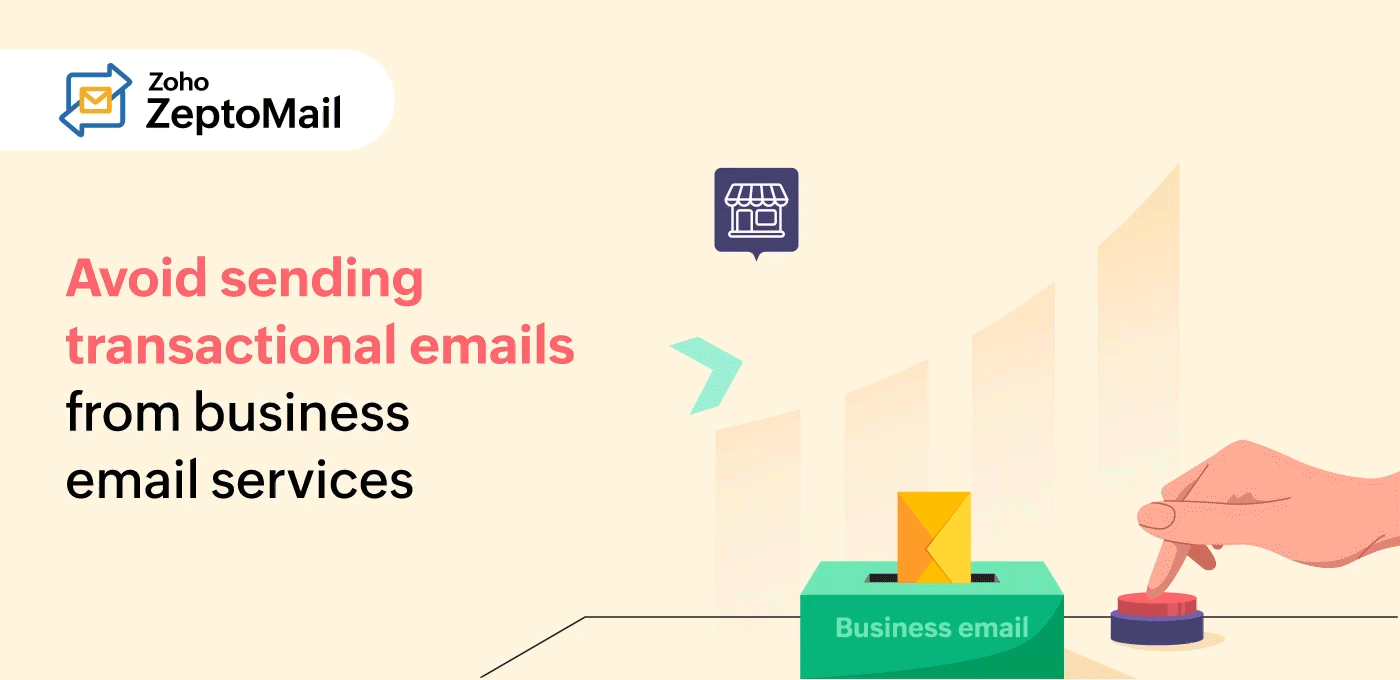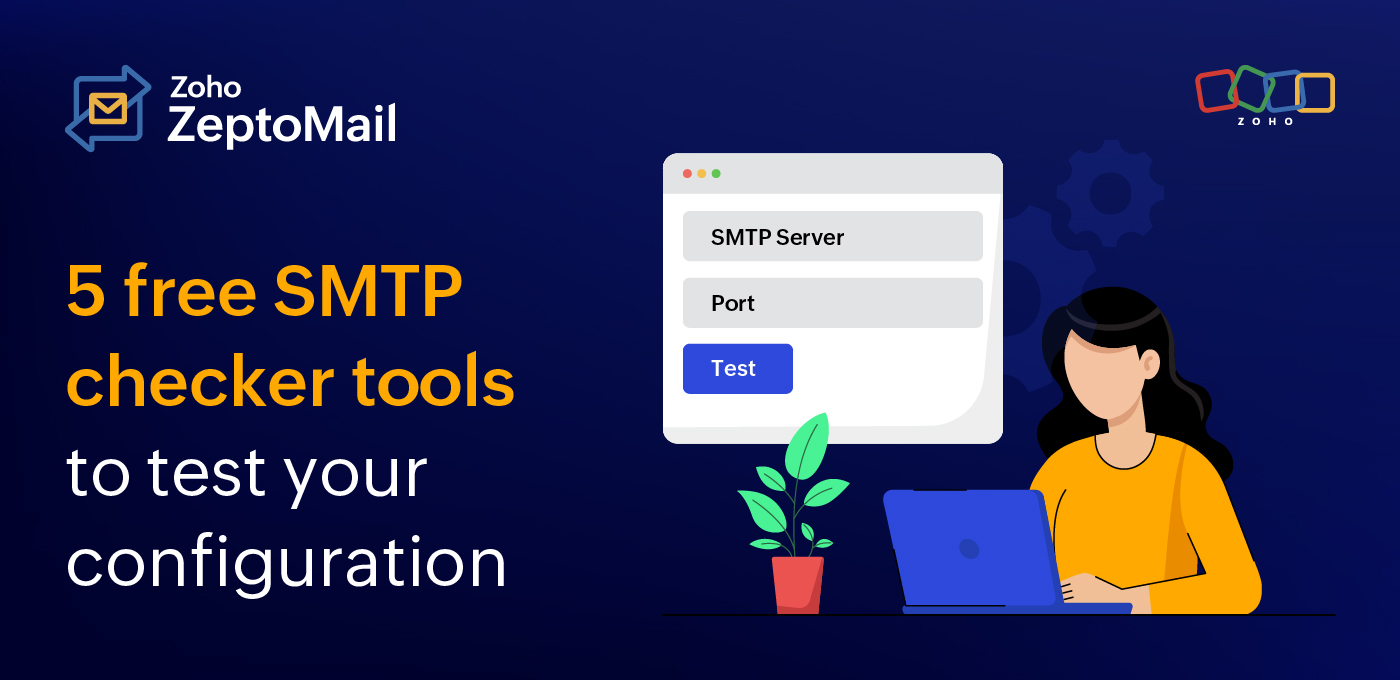- HOME
- Deliverability
- Why you shouldn’t use business email providers like Google, Outlook, or Zoho Mail to send your transactional emails
Why you shouldn’t use business email providers like Google, Outlook, or Zoho Mail to send your transactional emails
- Published : May 8, 2024
- Last Updated : December 5, 2024
- 500 Views
- 7 Min Read
A toothbrush helps keep your teeth clean and healthy, and you're familiar with it because you use it every day. But would you use the same toothbrush to brush your hair because you already have it and know how to use it? Probably not. Why? Because a toothbrush and a comb each have their own purpose. Each tool was built to fulfill its specific purposes well. So you wouldn't (or shouldn’t) use a toothbrush to brush your hair just because you possess it, know how to use it, and it would save you money.
Then why should you use a business email service to send out transactional emails just because you already have one?

A business email provider like Google, Outlook, Yahoo, or Zoho Mail is built for one-to-one email messages. These can be messages you send to your family, friends, or clients manually. On the other hand, transactional emails are automated emails sent from your app or website to your customers when they perform an action. These can be OTP emails, password reset emails, order confirmations, invoices, and more.
It might be tempting to use a familiar interface, but whether it’s a business email or a transactional email, each requires a tool that is optimized to handle them.
Disadvantages of using business email providers
The reasons why you shouldn't use business email providers for transactional email sending go beyond the performance and purpose of each tool. Good transactional email sending requires features that are not provided by business email services. This leaves you with many disadvantages if you choose to use a service like Google or Outlook for transactional email sending.
Account could be blocked
Business email services aren’t built for sending high volumes of emails. Actions your users take on your website trigger transactional emails, placing them in the high-volume category. Most business email providers have a daily limit on the number of emails you can send. Using them to send transactional emails can raise red flags and lead to ESP blocking your account.
Lack of isolation
Every business sends multiple types of emails, like business communication, transactional emails, marketing emails, and more. Isolating each type will prevent the deliverability of one type from being affected by delivery issues in another.
Not meant for automation
Your personal or business email accounts aren’t built with automation in mind. Most tasks, including sending email, are manual. You hit the “Send” button, and an email is sent out. In the case of transactional emails, the user’s action has to trigger the email. Using a transactional email service is much more productive than getting your business email to automate this process.
Limited design support
Most business communication happens in plain text, where you type out your message and then send the email out. This is the use case that the business email providers were built for. Though they have a templates feature, it’s meant mostly for you to save plain-text templates. When it comes to transactional emails, pre-built HTML templates for each type of email, like welcome email, order confirmation, invoice, and OTP, can both save a lot of time and leave a better impression with the customer.
No segmentation
There are many types of transactional emails, and sometimes you might be sending them from multiple businesses. Using a business email service will leave you unable to segment how these emails are sent, as well as other data of the different types of transactional emails.
Lack of personalization
Because transactional emails are triggered by a user’s action and often carry information unique to each user, it’s key to personalize these emails. In transactional email services, this is a basic functionality. Whereas in a business email service, you would have to spend hours to get the personalization right because they’re not meant for a high volume of personalized emails.
Complete lack of analytics
One of the biggest disadvantages of using business email services to send transactional emails is the complete lack of performance analytics available. This leaves you with no insights to improve the performance of your email. You need to know how your emails are performing and how users are interacting with them. All of this data, such as bounces, delivered, opens, clicks, the browsers used, and more, are easily available in a transactional email service whereas its not available in your business email service.
A feedback loop isn’t a top priority
One-on-one business messages are rarely considered spam. The occurrence of a direct email being marked as spam is rare, so most business email providers don’t have a comprehensive feedback loop tracking process. Even if they do, they may not provide you with the features required to take immediate action.
No proper list management
Spam complaints via feedback loops or frequent bounces are detrimental to your sender reputation. Business email services have contacts, but they don’t have the features to maintain suppression lists. Transactional email services do have these features to reduce bounces and spam complaints.
Domain authentication is optional
While most business email services have domain authentication, like SPF and DKIM, they are more often than not, optional. Your business emails might reach your recipient's inbox even without SPF and DKIM but the standards are different for high volume transactional emails. Lack of SPF and DKIM authentication is a sure-fire way to get your emails marked as spam.
Dependent on internet connection
Sending email from business email accounts requires an internet connection. The emails will be sent only when the inbox is connected to the internet. This will simply not work for automated emails like transactional emails that need to be sent in real time as the action happens. Transactional email services are built to send directly from the server immediately on receiving the trigger—irrespective of whether the account is connected to the internet or not.
More opportunity for mishaps
When it comes to transactional email services, the email sending and associated activities are mostly automated. This leaves little room for errors or mistakes to happen. In a business email account, it all comes down to your being able to manually carry out the activity without making any mistake. No matter how careful you are, things could slip into the cracks and could lead to issues in your email delivery or worse, customer data.
Advantages of using a business email service
We've discussed at length the disadvantages of using a business email service for transactional email service. But to be fair in our assessment, let’s also see what the advantages are and if they really stack up against the cons. We'll also see if there is an alternative.
Familiar interface
You’re familiar with how your business email account works, so there’s no learning curve.
Solution: Find a transactional emails service that is user-friendly and has an intuitive customer experience.
Low cost or no extra cost
If you use your business email account to send transactional emails too, you won’t have to pay extra for another service.
Solution: While this is true, a good tool with good deliverability doesn't always have to come with hefty price tags. You can find a service like Zoho ZeptoMail that has affordable pricing and a pay-as-you-go payment model.
Already set up and ready to use
You can avoid the additional work of having to set up a transactional email service by using your existing business email setup.
Solution: Most transactional email services provide multiple setup options that are fast and easy. For example, with ZeptoMail, you can use the SMTP configuration for a quick setup. It’s as easy as copying and pasting credentials.
Consequences of using a business email account for sending transactional emails
Now that you've seen both the pros and cons, it’s evident that the disadvantages of using a business email service for transactional email sending outweigh the minimal advantages by a large margin.
Even after reading about the disadvantages, you might say, "But it’s been working for me." This might be true now, but it might not continue to be true. One wrong turn or mishap can be enough to bring it all down. The consequences are merely a cascading effect that could lead to your losing customers. Here is a series of events that could occur.
Negative impact on sender reputation
Say you use business email services for transactional email sending. With no automated monitoring of the feedback loop and a lack of features to take immediate action to rectify it—like suppression lists—the reputation of the domain and the IP used for sending will be negatively impacted. In turn, it will lead to you acquiring a bad sender reputation.
Poor deliverability
A bad sender reputation will lead to poor deliverability of both your transactional emails and your business emails. Not only will you be unable to deliver important information to your customers, but even your message to a client could end up in a spam folder, leaving you unable to communicate efficiently.
Loss of customer trust
No one likes waiting for their OTP emails or password reset emails, and they want immediate confirmation of the transactional they’ve placed. No one trusts a business that’s unable to deliver these critical emails to their customers’ inboxes. Poor delivery of transactional emails could lead to your customers losing trust in your business or being skeptical of the authenticity of your business. This will directly lead to your brand reputation taking a hit.
Difficulty in customer retention
Once the customer has lost trust in your brand, there’s no reason why they would come back to your business. Poor email delivery and loss of trust will lead to you losing customers eventually. Delivering transactional emails immediately and accurately can make or break your customer retention strategy.
Wrapping up
Transactional emails are crucial for a business, and accurate delivery of these emails can be the difference between growing your business and losing your customers. The best way to ensure that it’s handled well is to employ a transactional email service that’s optimized and built specifically for this.
Zoho ZeptoMail is an email service handcrafted for transactional email sending. Unlike most of our competitors, we don’t even allow marketing emails to be sent from our platform. This exclusive focus on transactional emails allows us to ensure great inbox placement and delivery without any delays.











